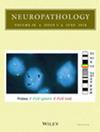Association between hypothalamic Alzheimer's disease pathology and body mass index: The Hisayama study
IF 1.3
4区 医学
Q4 CLINICAL NEUROLOGY
引用次数: 0
Abstract
The hypothalamus is the region of the brain that integrates the neuroendocrine system and whole-body metabolism. Patients with Alzheimer's disease (AD) have been reported to exhibit pathological changes in the hypothalamus, such as neurofibrillary tangles (NFTs) and amyloid plaques (APs). However, few studies have investigated whether hypothalamic AD pathology is associated with clinical factors. We investigated the association between AD-related pathological changes in the hypothalamus and clinical pictures using autopsied brain samples obtained from deceased residents of a Japanese community. A total of 85 autopsied brain samples were semi-quantitatively analyzed for AD pathology, including NFTs and APs. Our histopathological studies showed that several hypothalamic nuclei, such as the tuberomammillary nucleus (TBM) and lateral hypothalamic area (LHA), are vulnerable to AD pathologies. NFTs are observed in various neuropathological states, including normal cognitive cases, whereas APs are predominantly observed in AD. Regarding the association between hypothalamic AD pathologies and clinical factors, the degree of APs in the TBM and LHA was associated with a lower body mass index while alive, after adjusting for sex and age at death. However, we found no significant association between hypothalamic AD pathology and the prevalence of hypertension, diabetes, or dyslipidemia. Our study showed that a lower BMI, which is a poor prognostic factor of AD, might be associated with hypothalamic AP pathology and highlighted new insights regarding the disruption of the brain–whole body axis in AD.下丘脑阿尔茨海默病病理变化与体重指数之间的关系:久山研究
下丘脑是大脑中整合神经内分泌系统和全身新陈代谢的区域。据报道,阿尔茨海默病患者的下丘脑会出现病理变化,如神经纤维缠结(NFT)和淀粉样蛋白斑块(AP)。然而,很少有研究探讨下丘脑AD病理变化是否与临床因素有关。我们利用从一个日本社区的已故居民身上获得的尸检脑样本,研究了下丘脑中与AD相关的病理变化与临床症状之间的关联。我们对85份尸检脑样本进行了半定量分析,以确定AD病理变化,包括NFT和AP。我们的组织病理学研究表明,下丘脑的几个核区,如结节锤状核(TBM)和下丘脑外侧区(LHA),很容易发生AD病变。在包括正常认知病例在内的各种神经病理状态中都可观察到NFT,而AP则主要在AD中观察到。关于下丘脑AD病变与临床因素之间的关系,在调整了性别和死亡时的年龄后,TBM和LHA的AP程度与生前体重指数较低有关。然而,我们发现下丘脑AD病变与高血压、糖尿病或血脂异常的发病率之间没有明显的关联。我们的研究表明,较低的体重指数(AD的不良预后因素)可能与下丘脑AP病变有关,并强调了关于AD中脑-全身轴破坏的新见解。
本文章由计算机程序翻译,如有差异,请以英文原文为准。
求助全文
约1分钟内获得全文
求助全文
来源期刊

Neuropathology
医学-病理学
CiteScore
4.10
自引率
4.30%
发文量
105
审稿时长
6-12 weeks
期刊介绍:
Neuropathology is an international journal sponsored by the Japanese Society of Neuropathology and publishes peer-reviewed original papers dealing with all aspects of human and experimental neuropathology and related fields of research. The Journal aims to promote the international exchange of results and encourages authors from all countries to submit papers in the following categories: Original Articles, Case Reports, Short Communications, Occasional Reviews, Editorials and Letters to the Editor. All articles are peer-reviewed by at least two researchers expert in the field of the submitted paper.
 求助内容:
求助内容: 应助结果提醒方式:
应助结果提醒方式:


